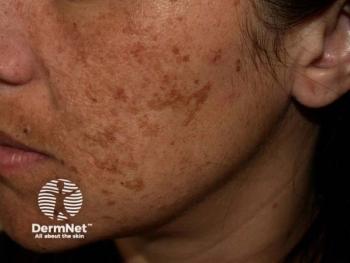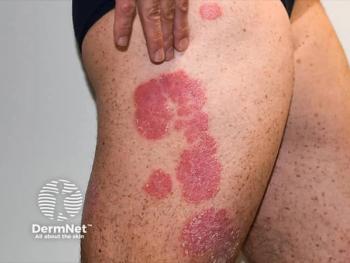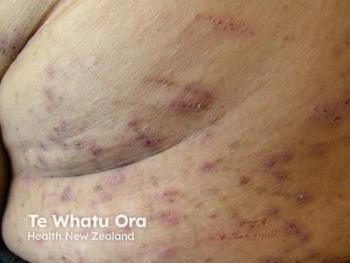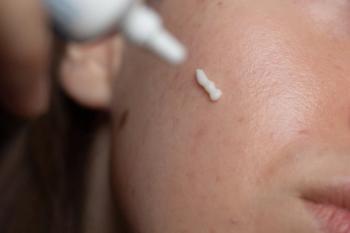
Abrocitinib Reduces Itch and Lesions in AD Trial
Key Takeaways
- Abrocitinib significantly improves lesion severity and pruritus in moderate to severe atopic dermatitis, outperforming placebo in clinical trials.
- The 200 mg dose of abrocitinib offers greater efficacy but is associated with more mild to moderate treatment-emergent adverse events.
Abrocitinib significantly improves lesion severity and pruritus in moderate to severe AD, offering a promising treatment option for patients.
A recent systematic review and meta-analysis published in the European Journal of Medical Research evaluates the clinical effectiveness of abrocitinib in treating moderate to severe atopic dermatitis (AD). The analysis, conducted by Kou et al, synthesized data from 5 randomized controlled trials (RCTs) encompassing over 2,000 patients to assess the impact of abrocitinib on lesion severity and pruritus. Results show that abrocitinib, a selective Janus kinase 1 (JAK1) inhibitor, offers significant clinical benefits in improving key disease outcomes while maintaining a manageable safety profile.1
Background
Existing treatment options for AD—such as topical corticosteroids and calcineurin inhibitors—often fall short for patients with moderate to severe disease.2 Abrocitinib represents a new class of oral systemic therapies that target the JAK-STAT pathway, specifically inhibiting cytokines like interleukin (IL)-4, IL-13, and IL-31, which are key drivers of inflammation and itch in AD.
Methods
The meta-analysis adhered to PRISMA guidelines and included RCTs that assessed abrocitinib’s effects on lesion area and pruritus. A comprehensive database search was conducted across PubMed, Embase, Web of Science, and the Cochrane Library. Eligible studies compared abrocitinib to placebo and reported on outcomes such as the Investigator’s Global Assessment (IGA), Eczema Area and Severity Index (EASI-75), and the Pruritus Patient Numeric Rating Scale (PP-NRS). The quality of the included trials was assessed using the Cochrane risk of bias tool.
Key Findings
All 5 studies reviewed demonstrated statistically significant improvements in clinical outcomes with abrocitinib compared to placebo. Notably:
- IGA scores: Patients on abrocitinib were more than twice as likely to achieve clear or almost clear skin (RR = 2.06, 95% CI [1.40–3.02]; P < 0.001).
- EASI-75 responses: Abrocitinib recipients were nearly 3 times more likely to reach a 75% reduction in disease severity (RR = 2.87, 95% CI [1.92–4.28]; P < 0.001).
- PP-NRS scores: The proportion of patients reporting a clinically meaningful reduction in pruritus (≥4-point improvement) was significantly higher with abrocitinib (RR = 2.29, 95% CI [1.70–3.10]; P < 0.001).
Dose-Response and Safety
The data revealed a clear dose-response relationship. The 200 mg dose yielded greater improvements in all primary efficacy outcomes compared to the 100 mg dose. However, this benefit came with an increased incidence of treatment-emergent adverse events (TEAEs), which were generally mild to moderate and resolved with discontinuation or supportive care. Importantly, there was no significant difference in serious adverse events (SAEs) between treatment and placebo groups (RR = 0.62, 95% CI [0.30–1.29]; P = 0.168).
Meta-regression analysis did not detect statistically significant differences in outcomes between the 2 dosage levels across the full data set, suggesting some flexibility in clinical decision-making when balancing efficacy and tolerability.
Discussion
The findings affirm abrocitinib’s role as a valuable therapeutic option for moderate to severe AD. Its selective inhibition of JAK1 enables targeted suppression of inflammatory pathways while preserving a tolerable safety profile. Researchers found the significant improvement in pruritus to be particularly notable, given the symptom’s impact on patient quality of life.
While comparisons with other JAK inhibitors (e.g., baricitinib, upadacitinib) were not included in this analysis, existing literature suggests comparable efficacy, though differences in onset of action and safety profiles warrant further head-to-head trials. Additionally, comparisons with dupilumab—a biologic targeting IL-4 and IL-13—highlight differences in mechanism and route of administration, offering clinicians greater flexibility based on patient preference and clinical presentation.
Conclusion
Abrocitinib demonstrates robust efficacy in reducing both lesion severity and pruritus in patients with atopic dermatitis, with a dose-dependent trend. Although higher doses are associated with increased TEAEs, the lack of increased SAEs supports its continued use in clinical practice. This meta-analysis supports abrocitinib as an effective and adaptable treatment for patients with moderate to severe AD who have not responded adequately to topical therapies. Researchers suggested further research is needed to evaluate long-term outcomes, direct comparisons with other systemic agents, and cost-effectiveness in broader patient populations.
References
- Kou XL, Ma SM, Wang JJ, Fan LF. The impact of abrocitinib treatment on lesion area and pruritus in patients with atopic dermatitis: a systematic review and meta-analysis. Eur J Med Res. 2025;30(1):617. Published 2025 Jul 14. doi:10.1186/s40001-025-02873-0
- Salvati L, Cosmi L, Annunziato F. From emollients to biologicals: Targeting atopic dermatitis. Int J Mol Sci. 2021;22(19):10381. Published 2021 Sep 26. doi:10.3390/ijms221910381
Newsletter
Like what you’re reading? Subscribe to Dermatology Times for weekly updates on therapies, innovations, and real-world practice tips.


















